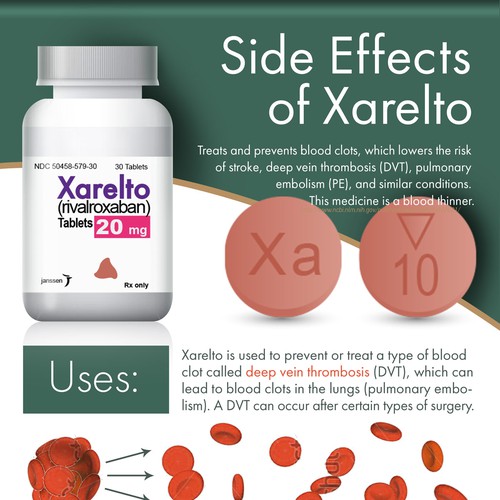Understanding Xarelto Side Effects: Safety and Usage Guide

Xarelto (rivaroxaban) is a widely prescribed anticoagulant used to prevent blood clots in certain medical conditions. While it is effective in reducing the risk of clot-related complications, it’s essential to be aware of potential side effects. In this blog post, we’ll explore common side effects of Xarelto, its usage in the elderly, and long-term effects to help you make informed decisions about your health.
Xarelto Side Effects:
Xarelto is generally well-tolerated, but like any medication, it can cause side effects. Common ones include:
- Easy bruising or bleeding
- Dizziness or weakness
- Swelling or pain in extremities
- Nausea or stomach upset
- Headache
Side Effects of Xarelto in the Elderly:
Elderly individuals may experience a higher risk of bleeding complications due to age-related changes in their bodies. It’s crucial for healthcare providers to monitor and adjust Xarelto dosage carefully.
Xarelto 10 mg and 20 mg Uses:
Xarelto comes in different strengths, and its uses vary based on the medical condition. The 10 mg dose is often prescribed for certain conditions, while the 20 mg dose is used for more severe cases.
Xarelto Side Effects After Stopping:
Abruptly stopping Xarelto without medical guidance can increase the risk of blood clots. If you need to discontinue the medication, consult your doctor to develop a safe plan.
Long-Term Side Effects of Xarelto:
Long-term use of Xarelto may increase the risk of bleeding, which could lead to serious complications. Regular check-ups with your healthcare provider are crucial to monitor any potential issues.
Xarelto Side Effects Fatigue:
Fatigue is a less common but possible side effect of Xarelto. If you experience excessive tiredness, discuss it with your healthcare provider.
Xarelto and Thrombocytopenia:
Thrombocytopenia, a condition characterized by low platelet levels, is a rare but severe side effect associated with Xarelto. Seek immediate medical attention if you notice unusual bleeding or bruising.
Frequently Asked Questions (FAQs) – Xarelto Side Effects
Q1: What are the common side effects of Xarelto (rivaroxaban)?
A1: Common side effects of Xarelto include easy bruising, bleeding, dizziness, weakness, swelling in extremities, nausea, and headache.
Q2: Are there specific side effects of Xarelto in the elderly?
A2: Elderly individuals may have a higher risk of bleeding complications while taking Xarelto due to age-related changes. Regular monitoring by healthcare providers is essential.
Q3: Can Xarelto 10 mg be used for any medical condition?
A3: Xarelto 10 mg is prescribed for specific conditions requiring anticoagulation. Always follow your doctor’s recommendations for the appropriate dosage and usage.
Q4: Are there side effects associated with stopping Xarelto?
A4: Stopping Xarelto abruptly may increase the risk of blood clots. If you need to discontinue the medication, consult your doctor to develop a safe plan.
Q5: What are the potential side effects of Xarelto 20 mg?
A5: Xarelto 20 mg is a higher dosage used for more severe cases requiring anticoagulation. It carries similar side effects as other strengths.
Q6: Can Xarelto be used for long-term treatment?
A6: Xarelto is sometimes prescribed for long-term use, but it may increase the risk of bleeding complications. Regular monitoring and follow-up with healthcare providers are crucial.
Q7: Can Xarelto cause fatigue as a side effect?
A7: Fatigue is a less common but possible side effect of Xarelto. If you experience excessive tiredness, discuss it with your healthcare provider.
Q8: What is Xarelto thrombocytopenia, and how serious is it?
A8: Thrombocytopenia is a condition characterized by low platelet levels. While it’s a rare side effect of Xarelto, it can be severe and requires immediate medical attention if suspected.
Q9: Are there any specific precautions for using Xarelto in the elderly population?
A9: Elderly individuals may require lower Xarelto dosages due to potential bleeding risks. Doctors carefully adjust the medication for older patients.
Q10: Can Xarelto 10 mg be used for stroke prevention?
A10: Xarelto 10 mg may be prescribed for stroke prevention in certain conditions. Always follow your doctor’s recommendations for the appropriate use.
Conclusion:
Xarelto is a valuable medication for preventing blood clots, but it’s essential to be aware of potential side effects. Always follow your doctor’s instructions, share your medical history and current medications, and report any unusual symptoms promptly. If you experience severe or persistent side effects, seek medical attention immediately. Your healthcare provider will work with you to ensure that the benefits of Xarelto outweigh any potential risks, helping you maintain a healthy and balanced life. Remember, open communication with your healthcare team is vital for your well-being.




